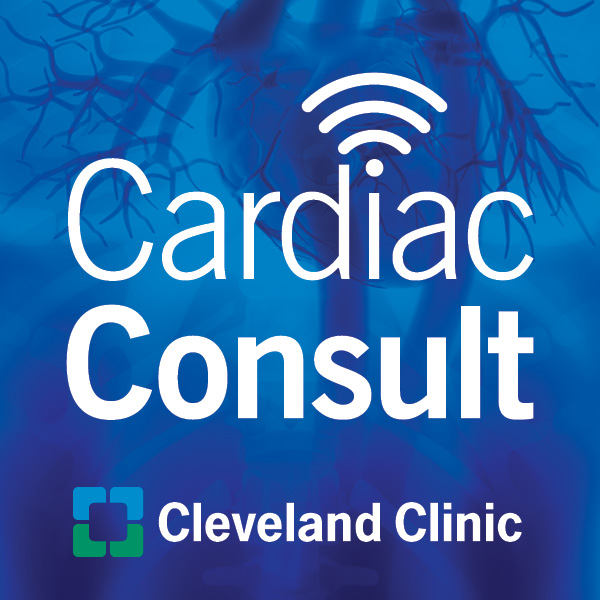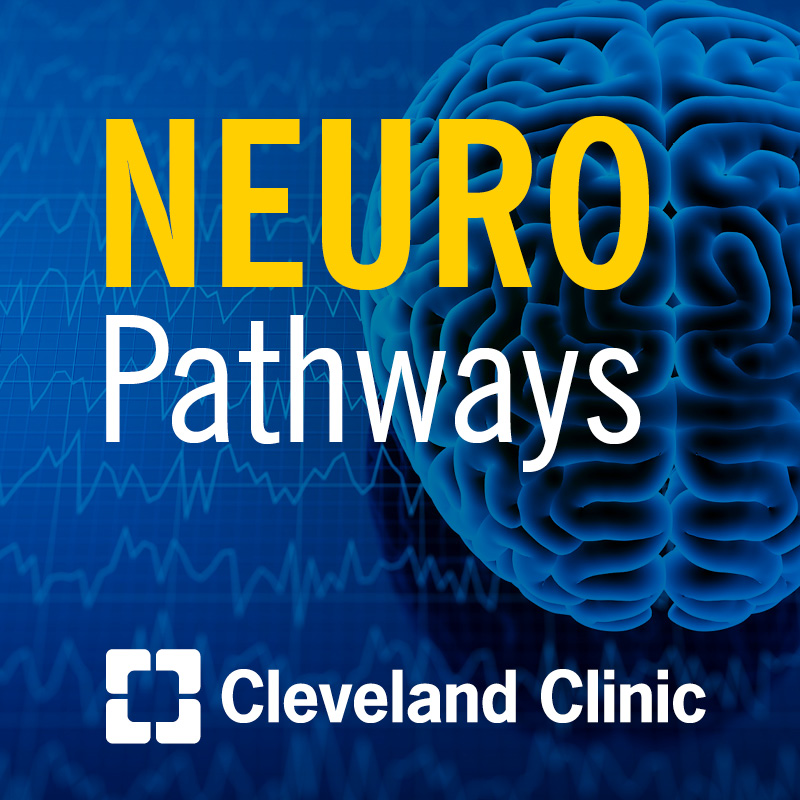Talking Tall Rounds®: Embolic Stroke

Featuring a case presentation on embolic stroke of undetermined source and Joanna Ghobrial, MD discussing ASD /PFO Management.
Enjoy the full Tall Rounds® & earn free CME
- Case Presentation: Divyang Patel, MD
- Etiological Workup of the Stroke Patient: M. Shazam Hussain, MD
- ESUS and Recent Trials: Andrew Russman, DO
- Hypercoagulable Screen: Marcelo Gomes, MD
- Atrial Fibrillation Screening: Khaldoun Tarakji, MD
- ASD /PFO Management in this Patient Population: Joanna Ghobrial, MD
Subscribe: Apple Podcasts | Podcast Addict | Buzzsprout | Spotify
Talking Tall Rounds®: Embolic Stroke
Podcast Transcript
Announcer:
Welcome to the Talking Tall Rounds Series brought to you by the Sydell and Arnold Miller Family Heart, Vascular & Thoracic Institute at Cleveland Clinic.
Divyang Patel, MD:
So this is a 70-year-old woman. She has a history of hypertension, hyperlipidemia. She recently presented at ER with dizziness and left eye ptosis. She had a CT negative for any acute bleeding and thrombolytics were not administered because of mild symptoms. She had an MRI consistent with small subacute infarcts involving the cerebellum. She had a workup, which our Neurology colleagues do, which included a CTA, head and neck transthoracic transesophageal echocardiogram, which didn't show evidence of a PFO. And she underwent 30-day ambulatory rhythm monitoring, which were unrevealing.
Divyang Patel, MD:
She was referred to our EP Clinic for an implantable loop recorder. However, the patient was digitally savvy and bought a smartwatch and she had recordings that she brought to the clinic with her showing evidence of atrial fibrillation, so multiple events of atrial fibrillation. If you look at the closer recording analysis, you have what's classic, the hallmark of atrial fibrillation, irregularly irregular rhythm without clear P waves. The patient's smartwatch with the electrophysiology review in the clinic confirmed atrial fibrillation. Given her CHADS-VASc score of 5, she was started on anticoagulation. Initially, she was referred for loop recorder implantation. We did not need to implant a loop recorder and started her on anticoagulation.
Joanna Ghobrial, MD:
I'm going to be discussing PFO and ASD management in patients with stroke, specifically, patients that have an embolic stroke of undetermined source. And by the time the patients actually come to me, they already had a very thorough evaluation by my colleagues as clearly demonstrated by this Tall Rounds. So they've had both imaging studies and a comprehensive neurological and vascular and cardiac evaluation. Including an EP evaluation, to distinguish the type of stroke they had. I do want to emphasize that a cardiac source should always be considered specifically in the younger patients. And it is a multidisciplinary approach as Dr. Tarakji demonstrates. Now stroke doesn't spare anyone, it occurs in both the young and the old, even the pediatric population. This first graph here demonstrates that you do have obviously an increased incidence of stroke as you get older. But if you look at the bar graph, the red is the stroke of an undetermined source and the green is part to the embolic stroke.
Joanna Ghobrial, MD:
And it is a big chunk of the etiology of strokes in the younger population. So this has already been presented by my colleagues. You have the definite cardiac source, but part of the definite cardiac source, other than AFib and rheumatic valve disease and endocarditis, is congenital heart disease, including an atrial septal defect. And part of the possible cardiac source, which falls sometimes under the embolic stroke of an undetermined source, is an atrial septal aneurysm as well as a patent foramen ovale. So paradoxical embolism has a lot to do with these two pathologies. A paradoxical embolism is essentially something on the right side of the heart, whether a venous thrombosis, a PE, right heart endocarditis, right heart valve disease. Or unknown source clearly, that then crosses over through some kind of shunt and then causes an embolism, including a stroke. This can be intracardiac, such as PFO or ASD, but it can also be at the pulmonary level. So an arteriovenous malformation, usually large enough to allow this kind of embolism.
Joanna Ghobrial, MD:
This hear demonstrates ice images, actually of a patient with a clot, literally in the pulmonary artery on this screen here. And then on this one, a clot in the SVC, this is from the same patient, and the patient had a large PFO. So part of the cardiac evaluation for shunt, first off, and this is for you, Dr. Tarakji, is absolutely rule out Afib because it's still one of the main sources for that and a minimum of 30 days, and we usually do advocate for longer-term monitoring. But you do, do Transcranial Doppler with bubbles, which are very sensitive for any kind of shunting, but it picks up both intracardiac and intrapulmonary. Then transthoracic echo, obviously with bubble studies is the preferred initial test. It's the least invasive, the TEE or transesophageal echo has greater sensitivity and specificity. And it gives me a really good anatomy of what I'm dealing with. Is it an ASD? What kind of ASD? And the anatomy of a PFO, and is it high risk or not?
Joanna Ghobrial, MD:
Intracardiac echo is excellent, but it's obviously usually procedural, this requires a venous access. And this here is an image of, a T image of a PFO. Now an ASD is not a PFO. They cannot be used interchangeably the terms, an ASD in an actual defect. It's a congenital heart defect. And it can be a secundum ASD, which is a defect in a septum, primum, a primum ASD, an unroofed coronary sinus right here, or a superior or inferior sinus venosus defects. All of these can cause embolism or stroke. A lot of these patients aren't going to be asymptomatic until adulthood symptoms can be quite vague. They do have risk of atrial arrhythmias. It's increased, especially as they get older.
Joanna Ghobrial, MD:
And there is a risk of paradoxical embolism, including stroke. You do close these if they have symptoms, if they have right heart enlargement or significant shunt. Obviously not if they have Eisenmenger physiology, but one of the indications for closure of ASD is paradoxical embolism, including stroke. Now atrial septal aneurysm is kind of a high risk feature in a PFO. But on its own, it's also been associated with stroke. And the definition is essentially a redundant or mobile interatrial septal tissue with excursion of more than 10 to 15 millimeters during your respiratory cycle. And the pathology thought behind that is you can have these little Fibrin-platelet particles on the left side of the atrial septal aneurysm. And with this extreme motion, it can actually be dislodged and cause some kind of stroke. It is again an increased prevalence, but not necessarily for sure, a causation. It is an association.
Joanna Ghobrial, MD:
Now a patent foramen ovale, as Dr. Russman showed, is not necessarily a pathology because it is present in anywhere between 20 to 34% of adults. Were actually all born with a PFO. And this shows the anatomy here, a PFO is essentially this tunnel connection between the septum primum and the septum secundum that we all have at birth. And as you're born the left atrial pressure exceeds that at the right atrium. And this is sealed closed in 75% of us. And then in the 25% of us, it is not. And it does not cause pathology or any kind of problems in the majority of patients that have PFOs. In a small population though it can cause stroke. So there is an increased prevalence of PFO and embolic stroke of undetermined source, especially when compared with those that have known causes both in the young and in the old.
Joanna Ghobrial, MD:
What are high risk PFO features? We've already mentioned the atrial septal aneurysm, this nice image clearly demonstrate a large shunt. If you look at the amount of bubbles that actually cross into the left atrium through the PFO. Flap mobility, a prominent Eustachian valve or Chiari network, as well as kind of that large separation between the primum secundum septum. There's been six major randomized clinical trials looking at whether we should be closing PFO in patients that have embolic stroke of undetermined source. And I will, I'm not going to go into details of this big slide, but essentially if you do a meta-analysis of all these randomized clinical trials, there is a reduced risk of recurrent stroke from 5.1% with medical therapy alone to 1.8% with PFO closure specifically in the embolic stroke of undetermined source. But you derive the most benefit when you really pick your patients. When you do that thorough evaluation that we do here at the Cleveland Clinic.
Joanna Ghobrial, MD:
And part of that process is going through what's called the RoPE and the Pascal score. So what is the RoPE score? Essentially, you're looking at patients that do you have already risk factors of good old plaque strokes, such as hypertension, diabetes, stroke, prior stroke or TIA. Or are you a smoker? Do you truly have a stroke on imaging and are you younger or not? And if you kind of accumulate a stroke that is greater than or equal to seven, then you do derive a great benefit from PFO closure. In addition to that, if you take the RoPE score and add the Pascal score, which looks at high risk PFO features, then you really narrow it down to the patients that will benefit the most. And the Pascal score then will put you into an unlikely PFO-related stroke, a possible or probable. And there is a clear benefit in PFO closure for those that fall under the possible and probable.
Joanna Ghobrial, MD:
And this is from a paper recently published in JAMA. This is actually our own data from the Cleveland Clinic. It's an abstract that was accepted at the ACC upcoming conference, where we looked at our own data at 280 patients that had PFO closure. Specifically also looking at the type of device that was used. And we did find that there was a little bit more residual shunting noted in the Amplatzer devices, a little bit more AFib noted than the Cardioform devices. But there was still no major outcome on stroke.
Joanna Ghobrial, MD:
Now with the embolic stroke and undetermined source and PFO, I've already covered. That one, PFO is common. Two, you do need a thorough evaluation before you consider closing a PFO. Three in the young patients, less than 60 years with a PFO and an embolic appearing infarct, and no other mechanism of stroke identified, you should consider PFO closure.
Joanna Ghobrial, MD:
And then those that opt to receive medical therapy. Then again, they're still ongoing studies, but you can do anti-platelet and you leave it up to the clinician. If they feel that they need anti-coagulation as well.
Joanna Ghobrial, MD:
But I do want to mention that there is an increased absolute rate of non-periprocedural atrial fibrillation in the patients that receive a PFO closure device. Probably has something to do with the metal that is implanted in the heart. There is this increased risk in the first 30 to 45 days that usually then goes away. It's fairly transient without any long-term persistence or recurrence. But there isn't sufficient evidence because we don't track these patients or monitor them long-term. And that's what we are trying to do here at the Clinic is monitoring long term of these patients. So at our PFO closure devices, there's two main that have FDA approved the GORE® CARDIOFORM, and the ABBOTT AMPLATZER, the PFO closure is fairly lower risk procedure.
Joanna Ghobrial, MD:
However, there's nothing that's risk-free. You can have intraprocedural risk, including vascular pulmonary vein injury and stroke itself, obviously is why we heparinize the patients. And then you can have post-procedural risks such as new onset AFib, which I mentioned, device embolization and erosion, which is extremely rare. This is just an ice image of a PFO. This is balloon sizing to kind of decide on what size PFO device should you be using. You essentially deploy the left-sided disc, then deploy the right-sided disc. You do want to make sure that you've captured all rims, superior, inferior, anterior and posterior on ice imaging. And then you release the device. ASD closure, again, very similar devices that'll have a thicker wider waste because again, it's a defect. There's actually a missing chunk of septum in ASDs. There's the GORE® CARDIOFORM and the Abbott Amplatzer as well. You do want to balloon size these patients. It's actually even more important in ASDs than in PFOs. And then this is an example of Amplatzer device than an ASD patient and a CARDIOFORM device in a ASD patient.
Joanna Ghobrial, MD:
I think it would be great to actually start looking into biodegradable devices. There are a lot of clinical trials ongoing that might actually mitigate that risk of potential AFib and definitely the risk of erosion. If you have something that doesn't persist in the heart, there's no metal in the heart over time. And just in conclusion for the key points for this an ASD is not a PFO. Having a PFO is common in embolic stroke of undetermined source. You do want a thorough evaluation to rule out any alternative mechanism of stroke before considering PFO closure. But in the select population, the younger patients that have a PFO and an embolic stroke or an undetermined source, and you have no other mechanism, you should consider PFO closure. And clearly this is a multidisciplinary approach that takes on vascular, neurology, cardiology and medicine. Thank you.
Announcer:
Thank you for listening. We hope you enjoyed the podcast. Like what you heard. Visit tall rounds online at clevelandclinic.org/tallrounds and subscribe for free access to more education on the go.

Cardiac Consult
A Cleveland Clinic podcast exploring heart, vascular and thoracic topics of interest to healthcare providers: medical and surgical treatments, diagnostic testing, medical conditions, and research, technology and practice issues.



